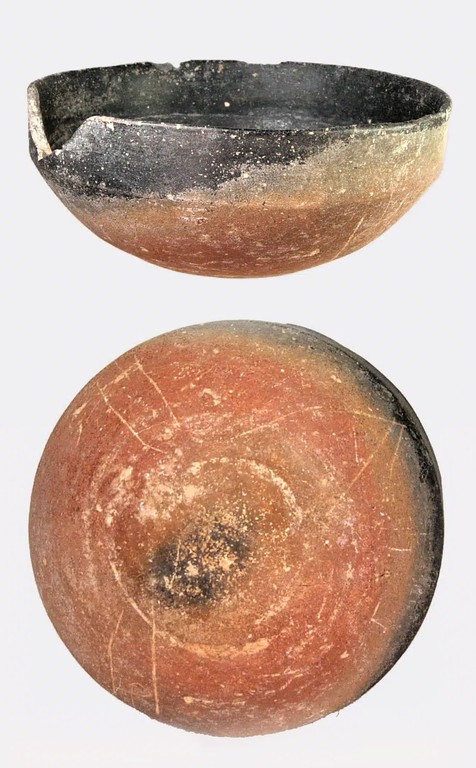Cypriot Small wheel-made cup with sgraffiti,: EC III - MCI (and LC – Classical)
A cup or very small bowl which is hard to categorise or date. It looks superficially like Red Polished Black-top Ware (EC III-MC I), with a round bottom and black interior and rim, but it also has a slight carination producing a vertical section below the rim, similar to some Proto Base Ring Ware bowls, though without a handle. More importantly it also seems to be wheel-made like Bichrome Ware and Plain White Ware, so should normally be late Bronze Age. However the potters wheel had been used since 1900BC in the Levant and since Early Bronze Age III in Anatolia (not to mention 1500 years earlier in Mesopotamia) so it is quite possible a potter from the continent settled in Cyprus in the ECIII-MCI period.
However it also has sgraffito marks on the underside which seem intentional and might represent signs from (a) Cypro-Minoan script (after 1500BC) or (b) the Cypriot Syllabary (Early Iron Age). They consist of 3 groups, scratched between the carination and near the bottom. These are (a) a nearly vertical arrow pointing upwards,(probably “ti” for both scripts), and (b) two pair of parallel, vertical or slightly sloped lines with line across the top (“ko”?), one pair possibly with loop between, the other with a short vertical. Other marks on each side might also be intentional (diagonals on left and short vertical with tilted reverse-L on right). Of course these could have been added later, but this might mean it had been kept unbroken for several hundred years or, more likely, had re-emerged from a tomb of 500 or 1500 years earlier. Another possibility is that the marks are modern, but this seems less likely.
One large and 3 small chips from rim. Some scrapes or accretions on base.
Size: 4.2 x 9.7cm
(Ex private collection of deceased Sussex gentleman who collected mostly Asian antiquities, 1970s and later. Sold by his wife, Bellmans auctions UK, part of multiple lot 2104, 24 Feb 2023.)
(Aquired Helios Gallery UK, 3 April 2023)
(DJ 248 AN 228)

